When did the Mexico City Mint produce its last gold Cobs?
by Phil Flemming
Standard reference works describe the hammered Mexican gold coinage launched in 1679 as a “cob coinage” and add that it lasted fifty-three years, until the milled, cordoncillo-edge Portrait Series was introduced in 1732. Mexico did strike a gold coinage for fifty-three years before the Portrait Series, but the question arises whether this coinage, certainly begun as a cob coinage, remained one for fifty-three years. In particular, is it correct to style the final phase of that coinage, in the so-called post-Fleet period from 1716 to 1732, a “cob coinage”? The coins themselves show us important changes and differences. Collectors of Mexican gold know, for example, that escudos from the last sixteen years of the “cob era” often do not look very much like their Fleet era (pre-1716) predecessors. As one veteran collector succinctly put it, “post-Fleet gold is usually rounder, smaller, and better struck.”
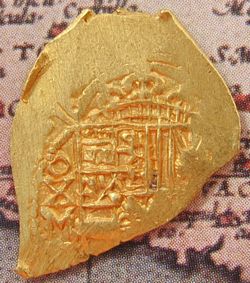 Why should rounder, smaller, and better struck matter to whether the 1716-1732 Mexican escudos remain part of a cob coinage? We must first sort out some terminology. The term “cob coinage” and its supposed Spanish equivalent, moneda macuquina, conceal some ambiguities. In his excellent little monograph on Fleet gold coins, Alan Craig Alan Craig, Spanish Colonial Coins in the Florida Collection (2000). p 14 writes, “each cob coin was struck by hand using lead-filled mallets on a gold or silver planchet, also handmade and of completely random form….” Notice that two quite distinct production issues are put together in this definition. How a coin is struck is not the same as how its planchet is prepared. Hammered coins are produced when a planchet (however prepared) is placed between two dies, the upper die being positioned by hand and then struck with a hammer. Cobs are a hammered coinage, but the distinctive feature of cobs, Craig observes, is the very irregular planchets they are struck on, adjusted for weight but not to achieve any kind of regular shape. The oXM J one escudo (circa 1709) shown to the left, perfect in weight at 3.35 gms, is a very typical cob of the Fleet period.
Why should rounder, smaller, and better struck matter to whether the 1716-1732 Mexican escudos remain part of a cob coinage? We must first sort out some terminology. The term “cob coinage” and its supposed Spanish equivalent, moneda macuquina, conceal some ambiguities. In his excellent little monograph on Fleet gold coins, Alan Craig Alan Craig, Spanish Colonial Coins in the Florida Collection (2000). p 14 writes, “each cob coin was struck by hand using lead-filled mallets on a gold or silver planchet, also handmade and of completely random form….” Notice that two quite distinct production issues are put together in this definition. How a coin is struck is not the same as how its planchet is prepared. Hammered coins are produced when a planchet (however prepared) is placed between two dies, the upper die being positioned by hand and then struck with a hammer. Cobs are a hammered coinage, but the distinctive feature of cobs, Craig observes, is the very irregular planchets they are struck on, adjusted for weight but not to achieve any kind of regular shape. The oXM J one escudo (circa 1709) shown to the left, perfect in weight at 3.35 gms, is a very typical cob of the Fleet period.
Regarding moneda macuquina, we should mention that, when many Spanish numismatists come to define this term, they refer only to how a coin is struck (a martillo) and not to the shape of its planchet. So Rafael Tauler in his recent, comprehensive Oro Macuquino (p. 9). Thus, according to the usage of these Spanish numismatists, it is correct to refer to the hammered 16th century silver coinage of Mexico as moneda macuquina, though Mexico City was clearly concerned to produce nearly round planchets. Recall that it is not until the reigns of Philip IV and his son Carlos that irregular-shaped silver planchets, “cobs” by Craig’s definition, took over Mexican reales production.
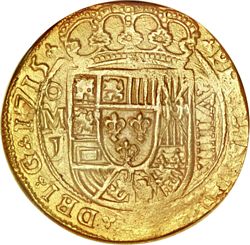 We shall use “cobs” in what follows in Craig’s sense, i.e. cobs are hammered coins struck on irregular planchets. Craig is absolutely correct in saying that almost all the thousands of Mexican gold coins found on the wrecks of the 1715 Fleet are cobs. These escudos date from the early 1680s through the first months of 1715. A very few special production gold coins, called galanos or royals, are also found on the Fleet. These round, special production coins (almost certainly milled or machine-struck) do not show that Mexico City was attempting a round, milled coinage before 1715, but the story is a little more complicated. Separate from the galanos, there are also some very round business strikes from 1713, 1714, and 1715. We picture a 1715 onza to the left. This coin is not struck from galano dies nor is it multiply struck on a specially polished planchet. It is not a “failed galano”, though sometimes so represented in the marketplace. It is a business strike in every sense except that it is a very round coin. The ratio of its maximum to minimum diameters is 1.02. Galanos sometimes exceed 1.01. Its edge show no trimming or shaving. It was struck on an almost perfectly round planchet that expanded just a little under the pressure of striking (Mexico had no collars). We are not sure how Mexico City prepared this planchet - a round, steel “cookie-cutter” punch is one theory - but it clearly has nothing to do with cutting irregular shapes off the end of a bar (i.e. producing cobs). Similar coins from 1713 and 1714 testify that this is not a one-off. If we expand our criterion of round to include “nearly round” with a diameter ratio of less than 1.15, then a significant number of the 1713-15 Mexican escudos are round or nearly round. This cannot be an accident. For a portion, perhaps significant percentage, of the production 1713-15, Mexico City is not using irregular cob planchets, but rather planchets that are round or nearly round.
We shall use “cobs” in what follows in Craig’s sense, i.e. cobs are hammered coins struck on irregular planchets. Craig is absolutely correct in saying that almost all the thousands of Mexican gold coins found on the wrecks of the 1715 Fleet are cobs. These escudos date from the early 1680s through the first months of 1715. A very few special production gold coins, called galanos or royals, are also found on the Fleet. These round, special production coins (almost certainly milled or machine-struck) do not show that Mexico City was attempting a round, milled coinage before 1715, but the story is a little more complicated. Separate from the galanos, there are also some very round business strikes from 1713, 1714, and 1715. We picture a 1715 onza to the left. This coin is not struck from galano dies nor is it multiply struck on a specially polished planchet. It is not a “failed galano”, though sometimes so represented in the marketplace. It is a business strike in every sense except that it is a very round coin. The ratio of its maximum to minimum diameters is 1.02. Galanos sometimes exceed 1.01. Its edge show no trimming or shaving. It was struck on an almost perfectly round planchet that expanded just a little under the pressure of striking (Mexico had no collars). We are not sure how Mexico City prepared this planchet - a round, steel “cookie-cutter” punch is one theory - but it clearly has nothing to do with cutting irregular shapes off the end of a bar (i.e. producing cobs). Similar coins from 1713 and 1714 testify that this is not a one-off. If we expand our criterion of round to include “nearly round” with a diameter ratio of less than 1.15, then a significant number of the 1713-15 Mexican escudos are round or nearly round. This cannot be an accident. For a portion, perhaps significant percentage, of the production 1713-15, Mexico City is not using irregular cob planchets, but rather planchets that are round or nearly round.
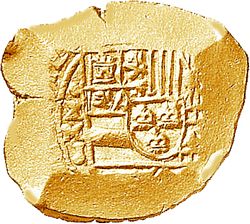 Lest we forget what a Mexican cob looks like, to the left is the only known dated 1712 onza. Many 1713 and 1714 Mexican escudos still show this degree of irregularity and heavy faceting, but alongside this cob coinage is a (much smaller) gold coinage that does not use cob planchets. Perhaps it is too speculative to assert that at the end of the Fleet era Mexico City is moving toward (or transitioning to) a rounded (non-cob) gold planchet, but then we need to consider this possibility in light of what gold planchets look like in the post-Fleet era. If cob-style planchet are gone (or almost completely gone) in the post-Fleet period (1716-32), then the shift we see beginning in 1713-15 is not an experiment or an anomaly, but a harbinger of the future, and to that extent, the end of the cob coinage is already in process in the last years of the Fleet era.
Lest we forget what a Mexican cob looks like, to the left is the only known dated 1712 onza. Many 1713 and 1714 Mexican escudos still show this degree of irregularity and heavy faceting, but alongside this cob coinage is a (much smaller) gold coinage that does not use cob planchets. Perhaps it is too speculative to assert that at the end of the Fleet era Mexico City is moving toward (or transitioning to) a rounded (non-cob) gold planchet, but then we need to consider this possibility in light of what gold planchets look like in the post-Fleet era. If cob-style planchet are gone (or almost completely gone) in the post-Fleet period (1716-32), then the shift we see beginning in 1713-15 is not an experiment or an anomaly, but a harbinger of the future, and to that extent, the end of the cob coinage is already in process in the last years of the Fleet era.
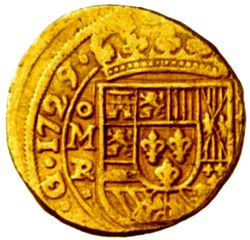 Let us examine a post-Fleet Mexican onza. Space permitting, we should examine in detail a dozen of these rare coins, but we must work from a few examples of the coinage. First we should emphasize that, without the benefit of the 1715 Fleet wrecks or a comparable hoard source, our knowledge of Mexican gold 1716-1732 is quite limited. This coinage is now quite rare. About thirty business strikes and four or five galanos represent all that survive of the 1716-1732 PHILIPPVS gold onzas. Years such as 1716, 1719, 1721-22, and 1726 have no dated survivors. The onza to the left is a 1729/7 R over D. Working assayer Jose Rivas (R), convicted and confined in the mint, succeeded himself by court order, dropping the assayer mark D (for Desierto) that he had used since 1724. This is a wonderful story that, alas, cannot detain or distract us here. The shape of this onza is a smooth ellipse with a maximum to minimum diameters ratio of 1.05. It is not a cob. The maximum diameter is a small (29.5 mm), about 1-2 mm smaller than average Fleet-era onza. Because it has such a small planchet, it is deliberately off-set to the right to show a clear four-digit date. It has the shield and crown designs that became permanent in 1715. Notice how well the shield is struck even at the rims. There are no flat spots or weak rims such as are very common on Fleet era escudos. There is no doubling! None of the problems that almost constantly beset hand-struck cobs re-appear on this coin.
Let us examine a post-Fleet Mexican onza. Space permitting, we should examine in detail a dozen of these rare coins, but we must work from a few examples of the coinage. First we should emphasize that, without the benefit of the 1715 Fleet wrecks or a comparable hoard source, our knowledge of Mexican gold 1716-1732 is quite limited. This coinage is now quite rare. About thirty business strikes and four or five galanos represent all that survive of the 1716-1732 PHILIPPVS gold onzas. Years such as 1716, 1719, 1721-22, and 1726 have no dated survivors. The onza to the left is a 1729/7 R over D. Working assayer Jose Rivas (R), convicted and confined in the mint, succeeded himself by court order, dropping the assayer mark D (for Desierto) that he had used since 1724. This is a wonderful story that, alas, cannot detain or distract us here. The shape of this onza is a smooth ellipse with a maximum to minimum diameters ratio of 1.05. It is not a cob. The maximum diameter is a small (29.5 mm), about 1-2 mm smaller than average Fleet-era onza. Because it has such a small planchet, it is deliberately off-set to the right to show a clear four-digit date. It has the shield and crown designs that became permanent in 1715. Notice how well the shield is struck even at the rims. There are no flat spots or weak rims such as are very common on Fleet era escudos. There is no doubling! None of the problems that almost constantly beset hand-struck cobs re-appear on this coin.
Photo of the 1729/7, the 1730, and 1717 onzas courtesy of Rafael Tauler, Escudos Macuquinos. The (unpublished) census of post-Fleet Mexican onzas courtesy of the Gold Cobs Co. For the full Jose Rivas story, see Jorge Proctor’s “The Hidden Mint Scandal of Mexico” (forthcoming, summer 2024).
Somewhat less round are the unique 1730 F (Tauler 416), 1731 F (Tauler 417), and 1732/30 F (Tauler 418).

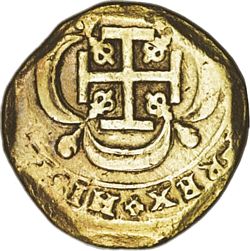
1730 F onza (Tauler 416)
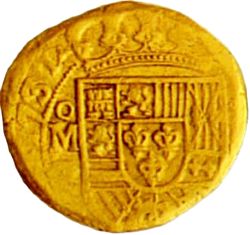
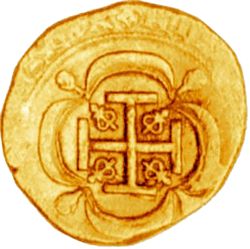
1731 F onza (Tauler 417)

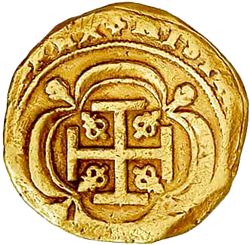
1732/30 F onza (Tauler 418)
Its ratio of maximum to minimum diameters of the 1730 F is about 1.05, but its shape is not a smooth ellipse. What we see on the cross side (not shown) are a half dozen small faceting marks, carefully angled so as not to cut across the edge and compromise the roundness of the coin, but still doing so slightly at several places such as 8 o’clock. In the post-Fleet era, Mexico City still had the problem of adjusting its escudos, many of which seem to have been struck at as much as 3-4% overweight. Mexico City never developed an alternative to rim faceting, which of course mars the designs and even the shape of the coin. In the post-Fleet era faceting is usually, and after 1725 rigorously, confined to the cross side.
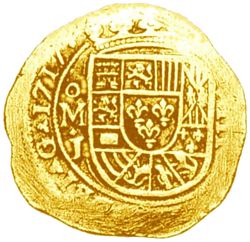
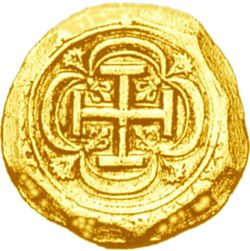
1717 J onza (Tauler 402)
The worst example of faceting I know of is shown on the 1717 J onza (Tauler 402). Depending on how you wish to count, eight or nine small faceting cuts nibble along the edge, carefully removing probably more than a gram from the overweight coin. Yet, when viewed from the obverse, it is still a very round coin. The diameters ratio is 1.04. We have an important lesson to learn from this coin. Some people will look at this coin, overlook its roundness, and declare, “It’s cob!” No, it isn’t. Faceting has nothing to do with how a planchet is prepared. Faceting is a method of adjusting the weight of a struck coin. A coin this round was struck on a round planchet, not cut without regard to shape from a strip of metal.
We are suggesting that post-Fleet escudos were struck on circular, not cob planchet. Faceting has apparently led some people to believe that faceted round coins are still cobs. They are not. Faceting, as we have seen, was usually done carefully, so as not compromise the shape of the coin or the important obverse legends. But occasionally faceting was applied incompetently. Tauler 410 (no reproducible image available) shows a 1728 D, an onza in which steep facet cuts even removed most of the date! Placing a compass in the center of the Bourbon escutcheon and circumscribing a 30 mm diameter circle, we can still see that before the faceting the 1728 D was nearly round.
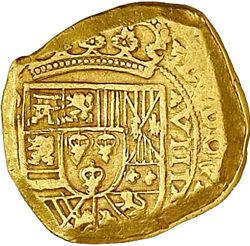 A compass will not help us with explaining the shape of one important post-Fleet onza. Pictured to the left is the unique LUDOVICVS onza, by far the most expensive post-Fleet gold coin, sold in the 2009 Caballeros sale (lot 364) for nearly 69,000 euros. The coin is struck on a small rectangular cob planchet (25 x 29 mm) from hand-held dies. There is significant doubling especially on the cross side. A corner on the cross side is also blunted and turned up with a hammer strike: a practice not common since Carlos II. Faceting is applied on the obverse, compromising parts of the crown, the shield, and the (all-important) LUDOVICVS. Notice how far the shield side strike is offset to the left, removing any room for the mint mark, the assayer, or the date. This was a no-no for the coiners. It is very rare for escudos to be struck that far offset to the left. The only reason for striking so far left must be to make LUDOV… visible, but then faceting compromises some of the king’s name. The designs are all correct. There are no grounds to question the authenticity of this unusual coin, but it is also a difficult coin to explain in the context of a post-Fleet mint committed to producing more attractive, round escudos. I am inclined to think some exceptional circumstance forced the Mexican mint to revert briefly to producing (a few?) cob planchets during the Luis I coinage. There we must leave it until some mint documents come to our rescue. The LUDOVICVS coin notwithstanding, I think it is clear that in the post-Fleet era the Mexico City coiners had abandoned the production of irregular cob planchets and were committed to producing as round a coin as they could.
A compass will not help us with explaining the shape of one important post-Fleet onza. Pictured to the left is the unique LUDOVICVS onza, by far the most expensive post-Fleet gold coin, sold in the 2009 Caballeros sale (lot 364) for nearly 69,000 euros. The coin is struck on a small rectangular cob planchet (25 x 29 mm) from hand-held dies. There is significant doubling especially on the cross side. A corner on the cross side is also blunted and turned up with a hammer strike: a practice not common since Carlos II. Faceting is applied on the obverse, compromising parts of the crown, the shield, and the (all-important) LUDOVICVS. Notice how far the shield side strike is offset to the left, removing any room for the mint mark, the assayer, or the date. This was a no-no for the coiners. It is very rare for escudos to be struck that far offset to the left. The only reason for striking so far left must be to make LUDOV… visible, but then faceting compromises some of the king’s name. The designs are all correct. There are no grounds to question the authenticity of this unusual coin, but it is also a difficult coin to explain in the context of a post-Fleet mint committed to producing more attractive, round escudos. I am inclined to think some exceptional circumstance forced the Mexican mint to revert briefly to producing (a few?) cob planchets during the Luis I coinage. There we must leave it until some mint documents come to our rescue. The LUDOVICVS coin notwithstanding, I think it is clear that in the post-Fleet era the Mexico City coiners had abandoned the production of irregular cob planchets and were committed to producing as round a coin as they could.
Careful readers of this paper will notice that, except for some brief remarks regarding the 1729/27 R, I have skated over the second part of the “cob coinage” story. The question would be, were post-Fleet escudos still a mostly or completely a hammered coinage? To do justice to this question would convert this paper into a monograph. Once again we are without useful archival guidance. We do know that when Torres’ ship, the San Miguel, was lost in 1729 carrying six new coin presses for the cordoncillos, Mexico City declined the expensive Spanish replacements, saying they could easily manufacture the replacements themselves. We believe the Mexican talladores had developed considerable expertise with the presses in producing the beautiful, multiply-struck galanos of Philip V. We do not know from any archival source whether the Mexican mint also began striking part of the post-Fleet business coinage with presses. For this we must depend on the evidence of the coins, and that is a complicated story. Certainly many of the post-Fleet escudos do not show the striking problems we typically encounter on Fleet era coinage, but we must leave a useful study of this to another time.
